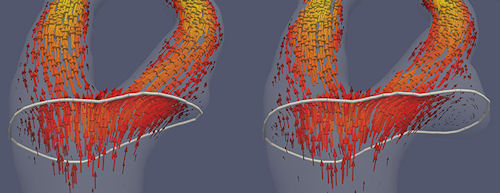Do Not Remesh. Morph Instead
November 18, 2013
 Dear Desktop Engineering Reader:
Dear Desktop Engineering Reader:
Too much starting over at the beginning kills innovation. For example, I hated manual typewriters because I am a lousy typist, have poor handwriting, and am a bit of a nutjob. I could never get anywhere with them because I simply had to fix a typo or recast a sentence before I could clackity-clack on. By the time I fixed what irked me, I had forgotten the brilliant locution that inspired me. Word processing freed me from the editing bonds because it’s so easy to change things.
 Courtesy Dr. Raffaele Ponzini, Dr. Luca Antiga, and Dr. Marco Evangelos Biancolini. |
I suspect that meshing, like a manual typewriter, plays a similar insidious, innovation-stifling role at many engineering joints. You know the drill: You get your geometry and spend seemingly forever making a mesh of it. You solve your CFD (computational fluid dynamics) model, evaluate the results, then you get the geometry modified, spend seemingly forever meshing it again, solve, and repeat. And repeat seemingly an endless number of times. This déjà vu all over again cycle eats up time and trains you with an “it’ll do” form of self-censorship because you’re spending more time and effort on the setup processes than on the what-if innovating. You simply cannot play with ideas when you’re constantly starting over way back at the beginning.
ANSYS has a new page in the Fluid Dynamics Technology Tips section of its website. It’s called “Do Not Remesh. Morph Instead.” It hits this button square on. You’re going to like this.
One of ANSYS’s partners, RBF-Morph, has developed some morphing technology that lets ANSYS Fluent users modify shapes through mesh updating on the fly. That means that you do not have to update your geometry until after you settle on a final design. Put another way, you create one mesh and then do 10, 20, 100, whatever number of runs. Your process becomes make a mesh, use morphing to play with ideas, then apply your best optimizations to the geometry. You can even use an old mesh to play with ideas before the updated CAD model is ready for you.
OK, now, RBF-Morph is both the developer and the acronym for Radial Basis Function technique. The technology works with large meshes, and it supports pretty much every kind of mesh element type. And it’s fast. My contact tells me that a mesh with 50 million cells can be morphed into a new mesh in seconds on an HPC (high-performance computing) cluster.
One of the keys here is that RBF-Morph recognizes parameters, so you can use it with ANSYS DesignXplorer to investigate design parameters or perform design optimization studies. RBF-Morph takes your input on something and then applies a series of RBFs that use your source-point inputs and their displacements to produce a solution for the mesh movement. It has a volume mesh smoother that maintains your volume mesh quality during morphing, BTW. Once you’ve come up with a shape that you believe in, you can apply that shape to your source geometry.
You might remember the August column on ANSYS’s Adjoint smart shape optimization technology. It’s the tool that uses CFD simulation results to find an optimal solution based on your stated goals and figures out how to modify your design to get there. The Adjoint solver RBF-Morph mesh morphing technology complement each other since you do not need to redefine the geometry nor recreate the mesh. You just morph the mesh to the new shape, run the Adjoint solver, and save tons of time and effort.
The “Do Not Remesh. Morph Instead” webpage has a lot of interesting materials explaining RBF-Morph. Download the “Shaping Up” and the “Mesh Morphing Accelerates Design Optimization” articles to learn how some engineers have applied RBF-Morph morphing technology to expand their innovation time. “Industrial Application of the Meshless Morpher RBF-Morph” offers the meaty technical details on optimizing a motorbike windshield design using morphing.
But really, if you just got your design back from the CAD guy so that you can remesh it yet again, or if you’re waiting for the CAD, take 2.5 minutes and watch the demo video at the bottom (or on the right; same one). Then compare and contrast it to what you’re doing. This is really good stuff. Hit the link and check out RBF-Morph for yourself.
Thanks, Pal. – Lockwood
Anthony J. Lockwood
Editor at Large, Desktop Engineering
Subscribe to our FREE magazine, FREE email newsletters or both!
About the Author
Anthony J. Lockwood is Digital Engineering’s founding editor. He is now retired. Contact him via [email protected].
Follow DE





